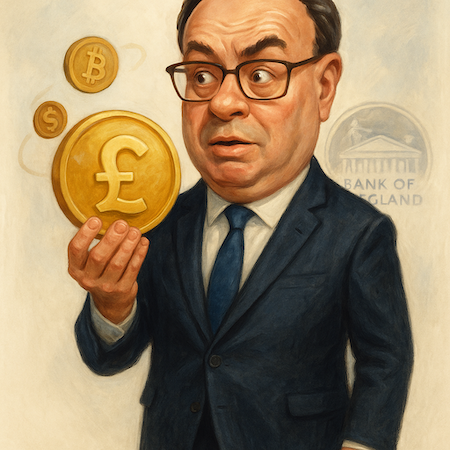 Bank of England Governor Andrew Bailey has abruptly shifted his tune on cryptocurrencies.
Bank of England Governor Andrew Bailey has abruptly shifted his tune on cryptocurrencies.
For years, Bailey and the FCA led Britain’s “broadly anti-crypto” stance, warning that bitcoin has “no intrinsic value” and urging people to “only buy if prepared to lose all their money”.
The FCA even banned crypto ETN products for retail investors as “ill-suited” to consumers, and Bailey publicly cautioned that stablecoins could strip money from the banking system and threaten financial stability.
In short, London regulators spent a decade dragging their feet on crypto innovation.
All that is now changing.
In a Financial Times piece Bailey acknowledged a stablecoin-driven future was imminent.
“…we will set out that widely used UK stablecoins should have access to accounts at the BoE to reinforce their status as money,”
“…it would be wrong to be against stablecoins as a matter of principle.”
He stressed that stablecoins “can co-exist” with banks in a new system separating money and credit.
In practical terms, the BoE will soon launch a consultation on stablecoin regulation, a complete 180-degree shift from Bailey’s earlier warnings.
I’m not all that surprised by this. And later on, I’ll give you proof I saw this coming five months ago.
A Decade of Crypto Scepticism in the UK
But it’s important to see just how inept Bailey has been until now on all this, mainly to understand just how quickly things are about to change.
Remember that in 2018, Bailey told Parliament that “bitcoin has no intrinsic value at all”, echoing years of FCA advisories that cryptocurrency is highly speculative.
The FCA outright banned retail crypto ETNs in 2021 and only agreed recently in 2025 to lift that ban on review.
In July, Bailey even insisted he was “not against stablecoins” but declared tokenized deposits offered “more value” and warned banks off issuing crypto-money.
That hardline stance has now cracked.
Why?
I’ll give you the one-word answer: Trump.
A little more detail will reveal that it’s Trump’s redollarisation strategy I’ve written to you about previously, and this idea of a “SmartDollar” stack that I think his administration is putting in place to keep the U.S on top of the long term (as in the next 200 years) economic pile.
Trump-backed legislation (the GENIUS Act) now provides a federal stablecoin framework, and Wall Street is preparing for a wave of crypto-friendly regulations.
The UK, notably Prime Minister Starmer, has no doubt had several in depth conversations with Trump about what they need the UK to do in order to ensure both sides of the Atlantic integrate nicely with this inevitable outcome.
So, in short, Bailey is reacting to an American-led wave with a gentle nudge it would seem from Number 10.
The “SmartDollar” Strategy
As I say, President Trump’s deliberate crypto focus has forced Britain’s hand. And it’s the basis of a SmartDollar strategy that I think it comes from.
In May, I wrote to you about Trump’s memecoin dinner to monetary strategy, saying,
“Expect the Trump administration to push regulatory clarity around U.S. dollar-backed stablecoins, and not just for domestic use. The goal is to embed stablecoins into real-world trade, particularly through AI-driven supply contracts and digital commerce agreements. They’re building frameworks for an entire digital economy, with digital assets as the primary settlement layer.
“Programmable stablecoins (not CBDCs – albeit pretty close to it) sanctioned by Washington, flowing through API-enabled contracts tied to global trade. This is how you redollarise the world without tanks, without SWIFT, and without asking permission.
“You simply use the already thriving crypto ecosystem.
“And once the U.S. establishes those digital corridors with the Middle East? The EU, the UK, and Asia will have no choice but to integrate. You can’t deny the huge wave of capital that involves. Just as the petrodollar became the global default in the 1970s, this new “smartdollar” could do the same in the 2020s and 2030s.”
And I concluded with,
“I do think it’s inevitable the U.S. adopts stablecoins, backed by bitcoin and bitcoin securities as their path to redollarisation.
And if I’m right, and they execute on this strategy, the question won’t be whether it’s adopted in the UK too, merely a question of how quickly Number 10 follows.”
And in June I explicitly explained how the SmartDollar stack is built,
1. The foundation: bitcoin as the strategic collateral layer.
More companies are holding BTC because they see what’s coming — inflation, currency devaluation, and an eventual “bitcoin standard” for treasury management. Not as a speculative side bet, but as core strategic collateral.
2. The application layer: USD stablecoins as the global settlement layer.
USDC, USDT and others are becoming the digital plumbing of global trade — faster, cheaper, programmable, borderless. For corporates and trade partners, stablecoins already offer a superior experience to legacy banking.
3. The settlement layer: US bitcoin-backed companies, banks, payment processors and digital trade organisations
21Capital, Strive Asset Management, Strategy, Metaplanet, Visa, PayPal, providing the services and trade functionality to make this system scalable globally and investable attracting huge sums of capital to feed back into the stack.
Note: you can also add Stripe, Circle and Coinbase too with their moves to build out massive crypto-based global payments and financial infrastructure.
Five months later from my explanations, we’re there.
Bailey’s onboard, consultation papers on the way and the inevitable move to the UK integrating USD stablecoins, and ultimately a GBP stablecoin into new, crypto-based financial systems is inevitable.
For investors in Britain, Bailey’s comments are a green light for crypto exposure.
The coming consultation and regulation mean mainstream avenues to stablecoins, and perhaps even re-approved ETNs, will open.
New FCA-authorized stablecoin funds, yield-funds and pension products could soon bridge UK portfolios to this digital dollar network.
This shift was inevitable given Trump’s move, and I would suggest that if you still have no crypto exposure, what exactly are you waiting for?
It may be via something like Circle, or Coinbase, or soon enough bitcoin directly through the impending ETNs.
With stablecoin payments poised to be part of global trade, and as I expect bitcoin as the underlying strategic collateral layer, for me, long term this is all a no brainer.
In short, Britain’s change of heart is no coincidence, it’s towing the line as per their U.S counterparts.
The UK must integrate or risk losing capital flows as U.S.-led crypto infrastructure reshapes global finance and trade.
As the “SmartDollar Stack” builds out, digital assets and related digital asset companies might just become the most important and profitable stocks in the market.
Until next time,

Sam Volkering
Contributing Editor, Investor’s Daily
P.S. If Trump’s “SmartDollar” agenda really is reshaping the future of global trade and payments — as Bailey’s sudden pivot seems to confirm — then you’ll want to see what else he may have set in motion. A former Reagan advisor claims this isn’t just about digital money… but the historic release of an estimated $150 trillion resource windfall buried beneath U.S. soil. And the kicker? British investors could have access, too. Here’s the full story.


